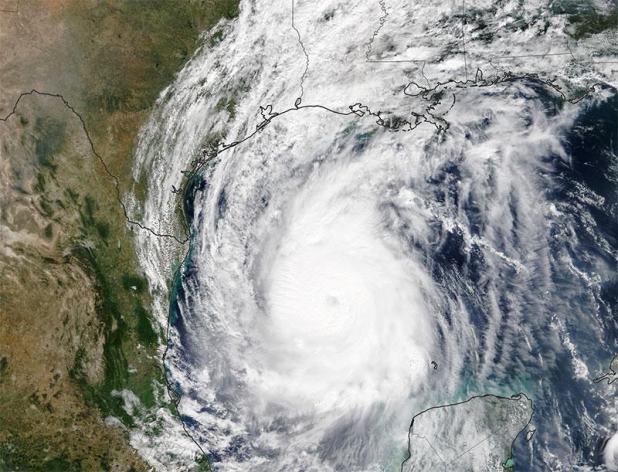
Hurricane Delta stalks the Louisiana coast in October. Greek letters won't be used again if the National Hurricane Center runs out of names for tropical systems.
NASA satellite image
From the Editor: What's new in hurricanes for 2021
Tuesday is the start of a new hurricane season, but the forecast doesn't seem new at all.
The National Oceanic and Atmospheric Administration says there's a 60% chance of more hurricane-related weather than average. The forecast from NOAA -- which, ominously enough, is pronounced "Noah" -- is for 13-20 named storms.
Colorado State University is expecting 17 named storms, four of them major.
All the numbers add up to one four-letter word: "Lots."
We've become accustomed to forecasts like that in this century. But that doesn't mean everything will be the same in 2021. Here are some ways this season will be different:
Flood forecast
for a fortnight
The National Weather Service in Lake Charles says that beginning June 15, the service will issue Atchafalaya River level forecasts for 14 days out. Currently, the forecast is for five days out.
The National Weather Service is making the change "to aid in longer planning for navigation and potential flood mitigation efforts," according to its website.
You can go to the webpage for the Atchafalaya River at Morgan City, for example, and find out what the river stage has been for the last three days. (Google "Morgan City river stage."). The forecast will show the anticipated stage every six hours for the next five days. Soon, it will extend to 14 days.
The change doesn't apply only to hurricane times. But on that page, you'll find that during Hurricane Barry on July 13, 2019, the storm surge pushed the river at Morgan City briefly to 10.06 feet. That's the third highest stage on record.
It's not
Greek to us
The 2020 hurricane season ripped through the alphabetical list of 21 traditional hurricane names (which excludes names starting with Q, U, X, Y and Z) and into Plan B, the Greek alphabet.
After the original list of names was exhausted, nine storms bore the Greek letter names, starting with Alpha on Sept. 7 and finishing with Iota Nov. 13.
It was the first time Greek letters had to be used since 2005. It was also the last time.
The World Meteorological Organization committee in charge of hurricane names decided that too much attention was paid last year to the Greek letters and not enough to preparedness.
So the committee has a back-up list of traditional names, a sort of hurricane junior varsity, ready to go.
The supplemental list contains the names Adria, Braylen, Caridad, Deshawn, Emery, Foster, Gemma, Heath, Isla, Jacobus, Kenzie, Lucio, Makayla, Nola, Orlanda, Pax, Ronin, Sophie, Tayshaun, Viviana and Will.
The first-line list of names for this year started with Ana, a tropical storm that drifted into oblivion May 21-23 in the Atlantic.
The next named storm will be Bill.
Closing time
The biggest change in hurricane preparedness this year is the new Bayou Teche Flood Control structure near Baldwin, which is all but finished and awaiting an official opening.
The St. Mary Parish Levee District project, funded mostly with a grant from the state Department of Transportation and Development, cost about $11.4 million.
A barge, constructed in Amelia, can be moved into place in a permanent structure to block storm surge from coming up the Charenton Canal into the Bayou Teche.
Closing the gate will reduce the hurricane flood threat in the Franklin, Garden City and Centerville areas.
The structure was in place but the barge wasn't during Hurricane Delta in October 2020. The district filled the gap in the structure with sheet pilings to block the storm surge.
This year, when a tropical system seemed to threaten the Louisiana coast May 21-23, the gate was ordered closed and operated as it should.
The district is also working on an extension of the Yokely levee and the $80 million Bayou Chene Flood Control Structure.
The new normal
NOAA's Climate Prediction Center has updated its calculation for the average hurricane season, basing the new number on the 1991-2020 period.
The average number of named storms is now considered to be 14 each season, up from 12 for the 1981-2010 period. Seven storms become hurricanes in the average season, up from six, and the average number of major hurricanes (Category 3 or stronger) remains unchanged at three.
The number you
are calling ...
State and local officials met virtually April 27 to talk about hurricane preparedness. NOAA's Tim Osborn noted that damage to cellphone towers made work difficult for first responders in areas that sustained heavy damage.
In addition to the lack of convenient communication, responders couldn't use their cellphone GPS to get where they needed to go.
Osborn asked the state to consider setting up portable cellphone infrastructure in areas where towers were knocked offline.
The Governor’s Office of Homeland Security agreed to check with service providers to see if the equipment is available.
Bill Decker is managing editor of The Daily Review.
